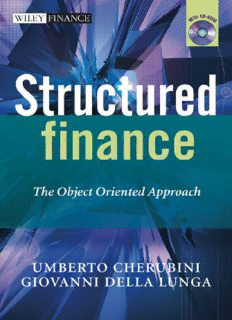
Structured Finance: The Object Oriented Approach (The Wiley Finance Series) PDF
Preview Structured Finance: The Object Oriented Approach (The Wiley Finance Series)
Structured Finance The Object-Oriented Approach Umberto Cherubini Giovanni Della Lunga Structured Finance For other titles in the Wiley Finance Series please see www.wiley.com/finance Structured Finance The Object-Oriented Approach Umberto Cherubini Giovanni Della Lunga Copyright©2007 JohnWiley&SonsLtd,TheAtrium,SouthernGate,Chichester, WestSussexPO198SQ,England Telephone (cid:2)+44(cid:3)1243779777 Email(forordersandcustomerserviceenquiries):[email protected] VisitourHomePageonwww.wiley.com AllRightsReserved.Nopartofthispublicationmaybereproduced,storedinaretrievalsystemortransmittedin anyformorbyanymeans,electronic,mechanical,photocopying,recording,scanningorotherwise,exceptunder thetermsoftheCopyright,DesignsandPatentsAct1988orunderthetermsofalicenceissuedbytheCopyright LicensingAgencyLtd,90TottenhamCourtRoad,LondonW1T4LP,UK,withoutthepermissioninwritingof thePublisher.RequeststothePublishershouldbeaddressedtothePermissionsDepartment,JohnWiley&Sons Ltd,TheAtrium,SouthernGate,Chichester,WestSussexPO198SQ,England,oremailedto [email protected],orfaxedto(+44)1243770620. Designationsusedbycompaniestodistinguishtheirproductsareoftenclaimedastrademarks.Allbrandnames andproductnamesusedinthisbookaretradenames,servicemarks,trademarksorregisteredtrademarksoftheir respectiveowners.ThePublisherisnotassociatedwithanyproductorvendormentionedinthisbook. Thispublicationisdesignedtoprovideaccurateandauthoritativeinformationinregardtothesubjectmatter covered.ItissoldontheunderstandingthatthePublisherisnotengagedinrenderingprofessionalservices.If professionaladviceorotherexpertassistanceisrequired,theservicesofacompetentprofessionalshouldbe sought. OtherWileyEditorialOffices JohnWiley&SonsInc.,111RiverStreet,Hoboken,NJ07030,USA Jossey-Bass,989MarketStreet,SanFrancisco,CA94103-1741,USA Wiley-VCHVerlagGmbH,Boschstr.12,D-69469Weinheim,Germany JohnWiley&SonsAustraliaLtd,42McDougallStreet,Milton,Queensland4064,Australia JohnWiley&Sons(Asia)PteLtd,2ClementiLoop#02-01,JinXingDistripark,Singapore129809 JohnWiley&SonsCanadaLtd,6045FreemontBlvd,Mississauga,ONT,L5R4J3,Canada Wileyalsopublishesitsbooksinavarietyofelectronicformats.Somecontentthatappearsinprintmaynot beavailableinelectronicbooks. AnniversaryLogoDesign:RichardJ.Pacifico LibraryofCongressCataloginginPublicationData Cherubini,Umberto. Structuredfinance:theobjectorientedapproach/UmbertoCherubini,GiovanniDellaLunga. p. cm.—(Wileyfinanceseries) Includesbibliographicalreferencesandindex. ISBN978-0-470-02638-0(cloth:alk.paper) 1. Structurednotes(Securities) 2. Derivativesecurities. 3. Investmentanalysis—Mathematicalmodels. 4. Financialengineering. I. DellaLunga,Giovanni. II. Title. HG4651.5.C462007 332.63(cid:2)27—dc22 2007010265 BritishLibraryCataloguinginPublicationData AcataloguerecordforthisbookisavailablefromtheBritishLibrary ISBN978-0-470-02638-0(HB) Typesetin10/12ptTimesbyIntegraSoftwareServicesPvt.Ltd,Pondicherry,India PrintedandboundinGreatBritainbyAntonyRoweLtd,Chippenham,Wiltshire Thisbookisprintedonacid-freepaperresponsiblymanufacturedfromsustainableforestry inwhichatleasttwotreesareplantedforeachoneusedforpaperproduction. Contents 1 Structured Finance: A Primer 1 1.1 Introduction 1 1.2 Arbitrage-free valuation and replicating portfolios 2 1.3 Replicating portfolios for derivatives 3 1.3.1 Linear derivatives 3 1.3.2 Nonlinear derivatives 3 1.4 No-arbitrage and pricing 5 1.4.1 Univariate claims 5 1.4.2 Multivariate claims 7 1.5 The structuring process 8 1.5.1 The basic objects 9 1.5.2 Risk factors, moments and dimensions 9 1.5.3 Risk management 11 1.6 A tale of two bonds 13 1.6.1 Contingent coupons and repayment plans 13 1.6.2 Exposure to the risky asset 14 1.6.3 Exposure to volatility 14 1.6.4 Hedging 15 1.7 Structured finance and object-oriented programming 15 References and further reading 17 2 Object-Oriented Programming 19 2.1 Introduction 19 2.2 What is OOP (object-oriented programming)? 19 2.3 Analysis and design 20 2.3.1 A simple example 20 2.4 Modelling 25 2.4.1 The unified modelling language (UML) 25 2.4.2 An object-oriented programming language: Java 26 2.5 Main ideas about OOP 27 2.5.1 Abstraction 27 2.5.2 Classes 28 2.5.3 Attributes and operations: the Encapsulation principle 28 vi Contents 2.5.4 Responsibilities 29 2.5.5 Inheritance 29 2.5.6 Abstract classes 34 2.5.7 Associations 34 2.5.8 Message exchanging 37 2.5.9 Collections 37 2.5.10 Polymorphism 37 References and further reading 42 3 Volatility and Correlation 45 3.1 Introduction 45 3.2 Volatility and correlation: models and measures 45 3.2.1 Implied information 47 3.2.2 Parametric models 47 3.2.3 Realized (cross)moments 47 3.3 Implied probability 48 3.4 Volatility measures 50 3.4.1 Implied volatility 50 3.4.2 Parametric volatility models 51 3.4.3 Realized volatility 54 3.5 Implied correlation 55 3.5.1 Forex markets implied correlation 55 3.5.2 Equity “average” implied correlation 56 3.5.3 Credit implied correlation 56 3.6 Historical correlation 57 3.6.1 Multivariate GARCH 57 3.6.2 Dynamic correlation model 58 3.7 Copula functions 59 3.7.1 Copula functions: the basics 59 3.7.2 Copula functions: examples 60 3.7.3 Copulas and survival copulas 61 3.7.4 Copula dualities 62 3.8 Conditional probabilities 63 3.9 Non-parametric measures 64 3.10 Tail dependence 65 3.11 Correlation asymmetry 66 3.11.1 Correlation asymmetry: finance 66 3.11.2 Correlation asymmetry: econometrics 68 3.12 Non-exchangeable copulas 68 3.13 Estimation issues 70 3.14 Lévy processes 71 References and further reading 72 4 Cash Flow Design 75 4.1 Introduction 75 4.2 Types of bonds 76 4.2.1 Floaters and reverse floaters 76 Contents vii 4.2.2 Convertible bonds 76 4.2.3 Equity-linked notes 76 4.2.4 Inflation-linked bonds 77 4.2.5 Asset-backed securities 77 4.3 Time and scheduler issues 78 4.3.1 Payment date conventions 78 4.3.2 Day count conventions and accrual factors 79 4.4 JScheduler 80 4.4.1 Date handling in Java 80 4.4.2 Data models 85 4.4.3 Design patterns 98 4.4.4 The factory method pattern 99 4.5 Cash flow generator design 99 4.5.1 UML’s activity diagram 100 4.5.2 An important guideline to the data model for derivatives: FpML 103 4.5.3 UML’s sequence diagram 109 4.6 The cleg class 110 References and further reading 111 5 Convertible Bonds 113 5.1 Introduction 113 5.2 Object-oriented structuring process 113 5.2.1 Financial asset class 114 5.3 Contingent repayment plans 114 5.3.1 Payoff class 115 5.4 Convertible bonds 117 5.4.1 Exercise class 117 5.5 Reverse convertible bonds 121 5.6 Barriers 121 5.6.1 Contingent convertibles: Co.Cos 121 5.6.2 Contingent reverse convertibles 122 5.6.3 Introducing barriers in the Payoff class 123 5.6.4 Parisian options: a short description 123 5.7 Pricing issues 125 5.7.1 Valuation methods for barrier options: a primer 125 5.7.2 The strategy pattern 126 5.7.3 The option class 127 5.7.4 Option pricing: a Lego-like approach 129 References and further reading 135 6 Equity-Linked Notes 137 6.1 Introduction 137 6.2 Single coupon products 137 6.2.1 Crash protection 138 6.2.2 Reducing funding cost 141 6.2.3 Callability/putability: compound options 142
Description: